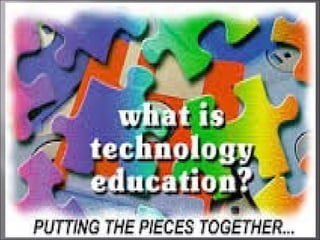Eductechpresentation
This document discusses four historical perspectives on educational technology: 1) The audiovisual movement of the 1930s which advocated using media like films and slides to more effectively deliver information than lectures. 2) Instructional technology perspective from the 1950s-1980s focused on using systematic approaches and media to develop effective, uniform instructional materials and training. 3) Technology education perspective from the 1980s believed school should prepare students for careers using technology and that vocational training is practical learning. 4) Educational computing perspective from the 1960s-1990s saw computers as potentially aiding instruction, initially for business/industry training but then also in classrooms.

Recommended
More Related Content
What's hot
What's hot (12)
Viewers also liked
Viewers also liked (14)
Similar to Eductechpresentation
Similar to Eductechpresentation (20)
Eductechpresentation
- 2. Education Technology defined it as both "the media born of the communication revolution which can be used forinstructional purposes ... " and "a systematic way of designing, carrying out, and evaluating the total process of learning and teaching. . ."
- 3. If educational technology is viewed as both processes and tools, it is important to begin by examining four different historical perspectives on these processes and tools, all of which have helped shape current practices
- 4. This perspective grew out of the audiovisual (AV) movement in the 1930s, when highereducation instructors proposed that media such as slides and films delivered information in more concrete, and therefore more effective, ways than lectures and books
- 5. Based on efficiency studiesand learning theoriesfrom educational psychology, they advocated using more planned, systematic approachesto developing uniform, effective materialsand training procedures.
- 6. This view was based on the belief that both human (teachers) and nonhuman (media) resources could be part of an efficient system foraddressing any instructional need. Therefore, they equated "educational technology" with "educational problem solutions."
- 7. Also known as technology education, this perspective originated with industry trainers and vocational educators in the 1980s. They believed : (1) that an important function of school learning is to prepare students forthe world of work in which they will use technology and (2) that vocational training can be a practical
- 8. This view brought about a major paradigm shift in vocational training in K- 12 schools away from industrial arts curricula centered in woodworking/metals and graphics/printing shops toward technology education courses taught in labs equipped with high-technology stations such as desktop publishing, computer-assisted design (CAD), and robotics systems
- 9. By the 1990s, educators began to see computers as part of a combination of technology resources, including media, instructional systems, and computer-based support systems. At that point, educational computing became known as educationaltechnology.
- 10. These computers and gained momentum when they began to be used instructionally in the 1960s. As computers began to transform business and industry practices, both trainers and teachers began to see that computers view began in the 1950s with the advent of also had the potential to aid instruction..
- 11. From the time computers came into classrooms in the 1960s until about 1990, this perspective was known as educationalcomputing and encompassed both instructional and administrative support applications